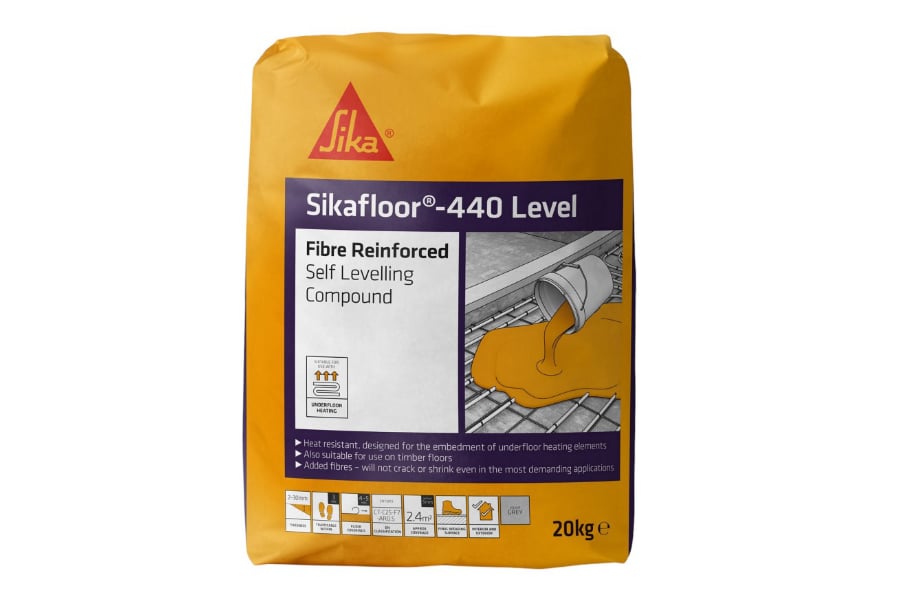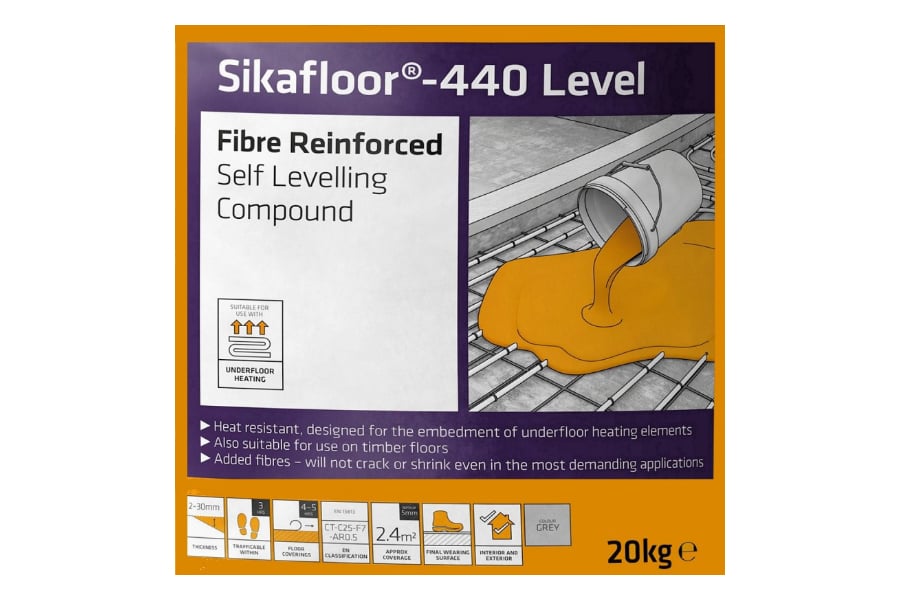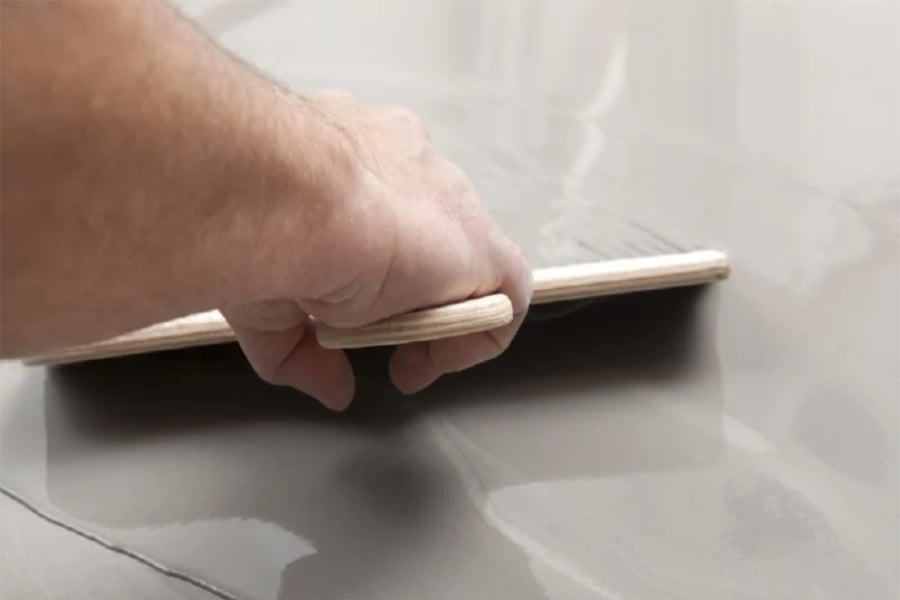Discover the Power of Sika Sikafloor 440
When it comes to achieving a flawless floor finish, Sika Sikafloor 440 stands out as a leading choice among self-levelling compounds. This innovative product, available for sale at Sealants and Tools Direct, is designed to simplify the process of creating smooth, level surfaces in both commercial and residential settings.
Let’s explore the features, benefits, and versatile applications of this product in greater detail.

Product Data at a Glance
Before diving into the specifics, here's a quick overview of its key characteristics and technical data:
| Product Information | Details |
| Packaging | 20kg Sack |
| Appearance/Colour | Fine grey powder |
| Shelf Life | 6 months from the date of manufacture |
| Storage Conditions | Cool, dry conditions, unopened bags clear of ground |
| Abrasion Resistance | BCA Wear Resistance Class AR 0.5 |
| Compressive Strength | 25N/mm² |
| Flexural Strength | 5N/mm² |
| Mixing Ratio | 20kg with 4.4 litres of clean water |
| Consumption | Covers approximately 2.4m² at 5mm depth |
| Layer Thickness | 2mm - 30mm |
| Ambient Air Temperature | 4°C to 35°C |
| Pot Life | 20 minutes at 20°C |
| Waiting Time/Overcoating | Foot traffic in 3 hours, floor coverings in 4-5 hours |

What is Sika Sikafloor 440?
This high-performance, fibre-reinforced self-levelling compound is specifically formulated to provide an exceptionally smooth, level surface with minimal effort. It is particularly valued in the construction and renovation sectors for its robustness and ease of application.
The compound’s formulation includes advanced fibre technology, which enhances its tensile strength and durability. This makes it particularly suitable for areas subject to heavy foot traffic or mechanical loads, such as commercial spaces, industrial settings, and high-traffic residential areas. The fibres within the compound work to reinforce the floor, reducing the risk of cracking and ensuring a long-lasting finish.
One of the key aspects that sets it apart is its self-levelling property. This feature allows the compound to flow and settle naturally, creating an even surface without the need for extensive manual levelling. This not only saves time but also ensures a consistent finish across large areas. The compound is designed to be easy to mix and apply, making it accessible to both professional contractors and DIY enthusiasts.
Moreover, the compound is compatible with a wide range of substrates, including concrete, screed, and other common flooring bases. This versatility makes it an ideal choice for various projects, from new constructions to refurbishments. Its quick setting time is another significant advantage, allowing for rapid progression to subsequent stages of the project, such as installing the final floor covering.
The smooth and even finish provided also reduces the need for additional surface preparation before laying tiles, carpet, or vinyl. This can lead to significant time and cost savings, further enhancing the product’s appeal.
Overall, this product is a comprehensive solution for anyone looking to achieve a high-quality, durable, and level floor with minimal effort. Its advanced formulation, ease of use, and versatile application make it a standout choice in the world of self-levelling compounds.
An In-depth Look at Fibre Reinforcement
The inclusion of fibres in the mix is not just a minor enhancement; it fundamentally changes the performance characteristics of the compound. The fibres act as a structural reinforcement within the compound, significantly increasing its tensile strength. This enhancement is particularly important in environments where the floor is subject to dynamic loads or frequent traffic. For example, in a commercial setting, the floor must withstand constant foot traffic, the movement of heavy equipment, and other stresses. Without reinforcement, a self-levelling compound might crack or degrade over time. The fibres distribute these stresses more evenly across the floor surface, preventing localised weaknesses and ensuring a longer lifespan for the floor.
The types of fibres used are designed to integrate seamlessly with the compound. They do not affect the mixing process or Sika Sikafloor 440. Instead, they enhance the overall matrix of the material, providing a form of internal scaffolding that supports the floor under stress. This innovation makes the compound a suitable choice for industrial settings where the integrity of the floor is critical to operational efficiency and safety.
Self-Levelling Properties Explained
Self-levelling compounds are designed to flow and settle naturally to create a smooth, even surface. The self-levelling property of this product is achieved through a carefully balanced formulation that allows the compound to spread out evenly when poured. This property is particularly useful in large-scale projects where achieving a consistent finish with manual methods would be time-consuming and labour-intensive.
The science behind self-levelling involves the interplay of various components within the compound. The product contains additives that reduce the surface tension of the mixture, allowing it to flow more freely. This flow is controlled to ensure that the compound does not spread too thin or too thick in any one area. The result is a perfectly level surface that requires minimal intervention during application.
This property is especially beneficial in commercial and industrial settings where time is a critical factor. The ability to quickly and efficiently create a level floor surface means that subsequent construction activities can proceed without delay. For instance, in a commercial renovation project, the speed at which a new floor can be prepared can significantly impact the overall timeline and cost of the project.
Compatibility with Various Substrates
One of the standout features of this product is its compatibility with a wide range of substrates. Whether you are working with concrete, screed, or other common flooring bases, this compound can be applied directly without the need for extensive preparation. This versatility makes it an ideal choice for both new constructions and refurbishments.
In new construction projects, the base substrate is often concrete. Concrete provides a durable and stable base, but it is rarely perfectly level. The compound can be used to create a smooth, level surface over the concrete, preparing it for the final floor covering.
In refurbishment projects, the existing substrate may be less predictable. It could be a mixture of different materials, or it could have areas of damage or unevenness. The ability to apply the compound over these substrates without extensive preparation simplifies the refurbishment process and reduces overall project costs.
Rapid Setting Time
The quick setting time is another major advantage. In construction and renovation projects, time is often a critical factor. Delays in one phase of the project can have a cascading effect on the entire timeline. This product is designed to set rapidly, allowing you to move on to the next stage of your project without unnecessary delays.
This rapid setting time does not compromise the performance or durability of the floor. The compound cures to a high-strength finish that is ready for foot traffic and subsequent construction activities within a relatively short period. This feature is particularly beneficial in commercial settings where minimising downtime is crucial. For example, in a retail environment, closing a store for renovations can lead to lost revenue.
The ability to quickly prepare and finish the floor means that the store can reopen sooner, minimising the impact on business operations.
Superior Surface Finish
The final finish provided by the compound is smooth and flawless, creating an ideal base for any flooring finish. The even surface reduces the need for additional preparation, such as sanding or filling, before laying the final floor covering. This can lead to significant time and cost savings, further enhancing the product’s appeal.
A smooth, level floor is not only aesthetically pleasing but also functional. In commercial settings, an even floor reduces the risk of tripping hazards, enhancing safety for both employees and customers. In residential settings, a level floor provides a stable base for furniture and reduces the risk of damage to the final floor covering.
In summary, this product is a comprehensive solution for anyone looking to achieve a high-quality, durable, and level floor with minimal effort. Its advanced formulation, ease of use, and versatile application make it a standout choice in the world of self-levelling compounds.

Application Tips for Best Results
Achieving the best results with Sika Sikafloor 440 involves a few key steps and considerations. While the product is designed for ease of use, following these tips can help you maximise its potential and ensure a flawless finish.
Surface Preparation
Proper surface preparation is crucial for the successful application of the compound. Ensure that the substrate is clean, dry, and free of dust, debris, or loose particles. Any existing cracks or holes should be repaired prior to application to create a stable and even base for the compound.
For more preparation products, check out the Tile Adhesive and Grout section for compatible adhesives and primers.
Mixing
Achieving the correct consistency is essential for optimal performance. Use a high-powered mixer to combine the compound with water, following the manufacturer’s recommended ratios. Mix until you achieve a smooth, lump-free consistency. This ensures that the compound flows and levels correctly during application.
The mixing process is straightforward but requires attention to detail. Following the manufacturer’s recommended ratios ensures that the compound achieves the correct consistency and performance characteristics. Using a high-powered mixer ensures a smooth, lump-free consistency, which is essential for the self-levelling properties of the compound.
Application Techniques
Depending on the scale of your project, you can apply the compound using a pump or manually with a trowel. For larger areas, a pump can facilitate faster and more efficient application. For smaller projects or touch-ups, a trowel allows for precise control and even spreading. Regardless of the method, ensure that the compound is evenly distributed across the surface.
Before application, ensure that floors are free from grease, dust, and loose particles and that substrates are porous. Floors should be dampened with water and primed with SikaBond® PVA+ or SikaBond® SBR+ diluted 1 part PVA/SBR to 3 parts water to provide a sound, slightly damp surface. Deep depressions and holes should be filled with a suitable repair mortar and allowed to dry.
For specific floor types:
- Sand/Cement Render: Allow at least four weeks for drying before application. Dampen floors and prime with SikaBond® PVA+ diluted 1:3 with water. For surfaces subjected to heavy foot traffic, use SikaBond® SBR+ diluted 1:1 with water when mixing the powder.
- Timber Floors: Ensure that the floorboards are securely screwed down at 300 mm centres. Apply SikaBond® SBR+ at a 1:1 dilution and apply the compound while the bonding coat is still tacky.
- Existing Vinyl Tiles: Ensure that the tiles are clean and sound. Prime with SikaBond® SBR+ diluted 1:1 with water and apply the self-levelling compound while the primer coat is still tacky. Allow 24 hours before applying the final covering.
Always add the powder to water—4.2-4.4 L of water per 20 kg of Sikafloor®-440 Level Fibre Reinforced. Do not use excess water. This should be carried out by stepwise addition whilst stirring until a free-flowing, creamy compound is produced. Pour the mixture onto the prepared floor and allow it to find its own level. Trowel down lightly to achieve an overall thickness not exceeding 30 mm. A minimum thickness of 10 mm is recommended for wooden substrates.
The application techniques are designed to be flexible and user-friendly. Whether you are working on a large commercial project or a small residential renovation, you can choose the most appropriate method for your specific needs. Using a pump for larger areas ensures a fast and efficient application, while a trowel allows for precise control in smaller projects.
Curing
Protect the freshly applied surface from rapid drying or direct sunlight to ensure optimal curing. Avoid subjecting the floor to heavy traffic or mechanical loads until it has fully cured. This helps maintain the integrity of the finish and ensures long-lasting durability.
The curing process is essential for achieving the best results. Protecting the freshly applied surface from rapid drying or direct sunlight ensures that the compound cures evenly and to the desired strength. Avoiding heavy traffic or mechanical loads until the floor has fully cured helps maintain the integrity of the finish and ensures long-lasting durability.
Final Preparations
The final preparations are straightforward and efficient. Once the compound has fully cured, you can proceed with installing the final floor covering without the need for additional preparation. This smooth and even surface reduces the need for sanding or filling, saving you time and effort and ensuring a high-quality finish.
In summary, this self-levelling compound offers a comprehensive solution for achieving perfectly level floors with minimal effort. Its advanced formulation, ease of use, and versatile applications make it a top choice for both professionals and DIY enthusiasts. By following these application tips, you can ensure a flawless finish that enhances the durability and aesthetic appeal of your space.
Frequently Asked Questions (FAQs)
What is Sika Sikafloor®-440 Level Fibre Reinforced?
Sika Sikafloor®-440 Level Fibre Reinforced is a heat-resistant, fibre and polymer-reinforced self-levelling compound designed for use with underfloor heating and for levelling uneven floors. It is suitable for various substrates, including concrete, timber, and existing tiles, and can be used as a final wearing surface or under most common floor coverings.
How do I prepare the floor before applying Sikafloor®-440 Level Fibre Reinforced?
Before applying Sikafloor®-440 Level Fibre Reinforced, ensure the floor is free from grease, dust, and loose particles. Dampen the floor with water and prime it with SikaBond® PVA+ or SikaBond® SBR+, diluting 1 part PVA/SBR to 3 parts water. This ensures a sound, slightly damp surface for optimal adhesion.
Can Sikafloor®-440 Level Fibre Reinforced be used on timber floors?
Yes, Sikafloor®-440 Level Fibre Reinforced can be used on timber floors. Ensure the floorboards are securely screwed down at 300 mm centres, apply SikaBond® SBR+ at a 1:1 dilution, and apply the compound while the bonding coat is still tacky for the best results.
How long does Sikafloor®-440 Level Fibre Reinforced take to set?
Sikafloor®-440 Level Fibre Reinforced is rapid-setting and can be walked on within approximately 3 hours at 20°C. It is ready to accept floor coverings in 4-5 hours under normal conditions.
What is the mixing ratio for Sikafloor®-440 Level Fibre Reinforced?
Mix 20 kg of Sikafloor®-440 Level Fibre Reinforced with 4.2-4.4 litres of clean water. Always add the powder to the water gradually while stirring to achieve a free-flowing, creamy compound.
Can Sikafloor®-440 Level Fibre Reinforced be used with underfloor heating systems?
Yes, Sikafloor®-440 Level Fibre Reinforced is specifically designed for use with underfloor heating systems. Ensure the heating is turned off 24 hours before and after application to avoid issues during the setting process.
What is the minimum and maximum layer thickness for Sikafloor®-440 Level Fibre Reinforced?
The layer thickness for Sikafloor®-440 Level Fibre Reinforced should be between 2 mm and 30 mm. For wooden substrates, a minimum thickness of 10 mm is recommended to ensure stability.
Can Sikafloor®-440 Level Fibre Reinforced be used on existing vinyl tiles?
Yes, Sikafloor®-440 Level Fibre Reinforced can be applied over existing vinyl tiles. Ensure the tiles are clean and sound, prime with SikaBond® SBR+ diluted 1:1 with water, and apply the compound while the primer coat is still tacky.
What substrates are compatible with Sikafloor®-440 Level Fibre Reinforced?
Sikafloor®-440 Level Fibre Reinforced is compatible with a variety of substrates, including concrete, sand/cement screeds, brick, stone, unglazed ceramic tiles, plastic sheet DPC, epoxy membranes, and wooden floors. It is suitable for both internal and external use.
Is Sikafloor®-440 Level Fibre Reinforced suitable for high-traffic areas?
Yes, Sikafloor®-440 Level Fibre Reinforced is strong enough to accept light vehicular traffic and is suitable for high-traffic areas. It can also be overlaid with a suitable floor covering or used as a final wearing surface.
Conclusion
This self-levelling compound is a revolutionary product in the world of flooring solutions. Its advanced fibre-reinforced formulation, combined with self-levelling properties, ease of application, and quick setting time, makes it an ideal choice for a wide range of flooring projects.
Whether you are working on commercial construction, industrial refurbishment, or residential renovation, this product provides a reliable solution that delivers exceptional performance and long-lasting results. Its versatility and excellent surface finish reduce the need for additional preparation, saving you time and effort.
By choosing this compound, you are investing in a product that combines the best of modern materials technology with user-friendly features. This ensures that you can achieve a high-quality, durable, and aesthetically pleasing floor with minimal hassle.
For more information, read the product data-sheet and use our search function to find "Sikafloor 440" on our website. Embrace the power of this advanced self-levelling compound and elevate your flooring projects to the next level.
